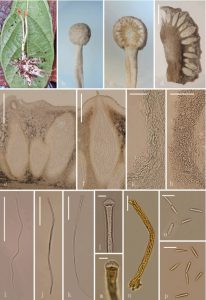hiocordyceps tettigonia T.C. Wen, Y.P. Xiao & K. D. Hyde, sp. nov., Index Fungorum number: IF 551451
Etymology: Refers to the unique host insect, Tettigonia.
Parasitic on an adult of Tettigonia. Host covered with white, dense mycelium, substratum buried in the soil, red to red-brown. Sexual morph: Stromata 35–40 mm long, 2–2.5 mm wide, growing from the head, with two branches. Stipe 32.5–37.5 mm long, 2 mm wide, flexuous, white. Fertile head 2–2.5 mm wide, globose, differentiated from stipe. Ascomata 520–680 × 205–275 μm (x̅ = 599 × 242 μm, n = 30), completely immersed, elongated or ampuliform, with the ostioles opening on the surface of the head. Peridium 22.8–35.0 μm (x̅ = 28.9 μm, n = 30) wide, comprised of three layers. Asci 530–615 × 6.5–9.3 μm (x̅ = 573.3 × 7.9 μm, n = 30), 8-spored, hyaline, cylindrical, possessing a prominent apical cap. Apical cap 3.9–4.8 μm wide (x̅ = 4.35 μm, n = 30). Ascospores 350–465 × 1.5–2.2 μm (x̅ = 407 × 1.8 μm, n = 60), fasciculate, thread-like, slender and long, breaking into secondary ascospores when mature. Secondary ascospores 6.7–9.4 × 1.5–2.3 μm (x̅ = 8.1 × 1.9 μm, n = 60), hyaline, cylindrical. Asexual morph: Undetermined.
Distribution: Chishui City, Guizhou Province, China.
Host: On adult of Tettigonia living in the soil.
Material Examined: CHINA. Guizhou Province: Chishui City, Shizhangdong scenic spot, Chishui Danxia natural world heritage site, on adult of Tettigonia in the soil, 9 June 2014, Ting-Chi Wen CS14062709 (GZUHCS14062709, holotype).
Notes: Ophiocordyceps tettigonia is distinctive in that it is associated with a unique host (Tettigonia adult), and it has wider secondary ascospores than related species. Although O. tettigonia is similar to O. amazonica, O. tettigonia has red Tettigonia adult host, while O. amazonica has yellow adult of Acrididae. Ophiocordyceps amazonica has red round fertile part, for O. tettigonia it is white. They also differ considerably in size of asci and ascospores (Kobayasi 1983). Ophiocordyceps tettigonia is similar to O. gracilis, but asci of O. tettigonia are longer and wider than those of O. gracilis, and secondary ascospores of O. tettigonia are much wider than in O. gracilis (Brady 1984). Ophiocordyceps gracilioides is similar to O. gracilis in its appearance, but their host insect is different, and secondary ascospores of O. gracilioides are much shorter than in O. gracilis (Fan et al. 2001). Combined sequence data from the ITS, SSU, TEF, and RPB1 gene loci also confirmed the distinctiveness of the new species.
FIG. Ophiocordyceps tettigonia (holotype). a Overview of stromata and the host. b Pale, superficial ascomata on stroma. c Cross section showing the complete stroma and perithecia. d–f Sections of ascomata. g, h Part of peridium. i–k Asci. l. Ascus with apical cap. m Ascus with apical cap stained by iodine solution. n Ascus stained by iodine solution. o Secondary ascospores. p Secondary ascospores stained by iodine solution. Scale bars: d = 1000 µm, e, f = 200 µm, g, h = 30 µm, i–k = 100 µm, l, m, o, p = 10 µm, n = 20 µm.

